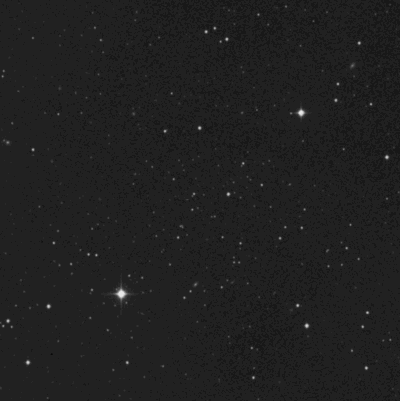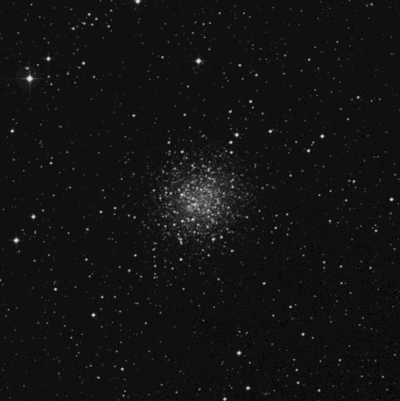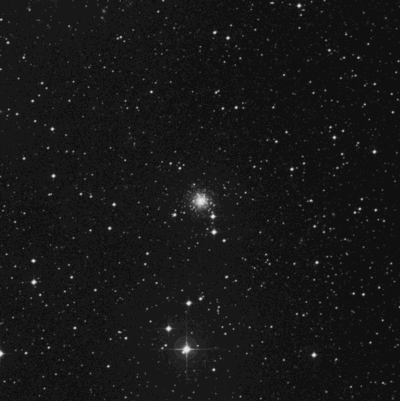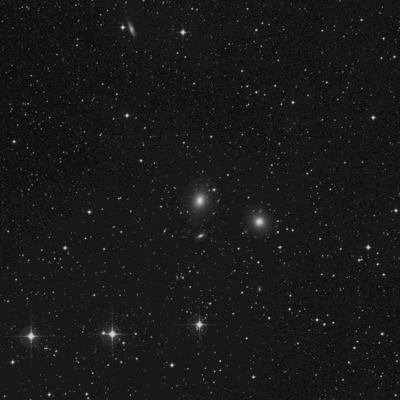Greetings, fellow SkyWatchers! It’s that time again and darker skies are in our favor for this weekend. Are you working towards Astronomical League studies? Then tag along as we seek out one of the most difficult of all targets – Palomar 5. But don’t despair – there’s just slightly easier ones to study, too! Come along for the double galaxy ride and the peak of two minor meteor showers as we head out into the night…
Friday, June 27 – As with all astronomical projects, there are sometimes difficult ones needed to complete certain fields of study – such as challenging globular clusters. Tonight we’ll take a look at one such cluster needed to complete your list and you’ll find it by using M5 as a guide.
 Palomar 5 is by no stretch of the imagination easy. For those using GoTo systems and large telescopes, aiming is easy…but for star hoppers a bit of instruction goes a long way. Starting at M5 drop south for the double star 5 Serpentis and again south and slightly west for another, fainter double. Don’t confuse it with 6 Serpentis to the east. About half a degree west you’ll encounter an 8th magnitude star with 7th magnitude 4 Serpentis a half degree south. Continue south another half degree where you will discover a triangle of 9th magnitude stars with a southern one at the apex. This is home to Palomar 5 (RA 15 16 05 Dec 00 06 41).
Palomar 5 is by no stretch of the imagination easy. For those using GoTo systems and large telescopes, aiming is easy…but for star hoppers a bit of instruction goes a long way. Starting at M5 drop south for the double star 5 Serpentis and again south and slightly west for another, fainter double. Don’t confuse it with 6 Serpentis to the east. About half a degree west you’ll encounter an 8th magnitude star with 7th magnitude 4 Serpentis a half degree south. Continue south another half degree where you will discover a triangle of 9th magnitude stars with a southern one at the apex. This is home to Palomar 5 (RA 15 16 05 Dec 00 06 41).
Discovered by Walter Baade in 1950, this 11.7 magnitude, Class XII globular is anything but easy. At first it was believed to be a dwarf elliptical and possibly a member of our own Local Group of galaxies due to some resolution of its stars. Later studies showed Palomar 5 was indeed a globular cluster – but one in the process of being ripped apart by the tidal forces of the Milky Way.
75,000 light-years away from us and 60,000 light-years from the galactic center, Palomar 5’s members are escaping and leaving trails spanning as much as 13,000 light-years…a process which may have been ongoing for several billion years. Although it is of low surface brightness, even telescopes as small as 6″ can distinguish just a few individual members northwest of the 9th magnitude marker star – but even telescopes as large as 31″ fail to show much more than a faint sheen (under excellent conditions) with a handful of resolvable stars. Even though it may be one of the toughest you’ll ever tackle, be sure to take the time to make a quick sketch of the region to complete your studies. Good luck!
While you’re out, keep a watch for a handful of meteors originating near the constellation of Corvus. The Corvid meteor shower is not well documented, but you might spot as many as ten per hour.
Saturday, June 28 – Before you start hunting down the faint fuzzies and spend the rest of the night drooling on the Milky Way, let’s go globular and hunt up two very nice studies worthy of your time. Starting at Alpha Librae, head five degrees southeast for Tau, and yet another degree southeast for the splendid field of NGC 5897 (RA 15 17 24 Dec -21 00 36).
 This class XI globular might appear very faint to binoculars, but it definitely makes up for it in size and beauty of field. It was first viewed by William Herschel on April 25, 1784 and logged as H VI.8 – but with a less than perfect notation of position. When he reviewed it again on March 10, 1785 he logged it correctly and relabeled it as H VI.19. At a distance of a little more than 40,000 light-years, this 8.5 magnitude globular will show some details to the larger telescope, but remain unresolved to smaller ones. As a halo globular cluster, NGC 5897 certainly shows signs of being disrupted, and has a number of blue stragglers, as well as four newly-discovered variables of the RR Lyrae type.
This class XI globular might appear very faint to binoculars, but it definitely makes up for it in size and beauty of field. It was first viewed by William Herschel on April 25, 1784 and logged as H VI.8 – but with a less than perfect notation of position. When he reviewed it again on March 10, 1785 he logged it correctly and relabeled it as H VI.19. At a distance of a little more than 40,000 light-years, this 8.5 magnitude globular will show some details to the larger telescope, but remain unresolved to smaller ones. As a halo globular cluster, NGC 5897 certainly shows signs of being disrupted, and has a number of blue stragglers, as well as four newly-discovered variables of the RR Lyrae type.
Now let’s return to Alpha Librae and head about a fistwidth south across the border into Hydra and two degrees east of star 57 for NGC 5694 – also in an attractive field (RA 14 39 36 Dec 26 32 18).
 Also discovered by Herschel, and cataloged as H II.196, this class VII cluster is far too faint for binoculars at magnitude 10, and barely within reach of smaller scopes. As one of the most remote globular clusters in our galaxy, few telescopes can hope to resolve this more than 113,000 light-year distant ball of stars. Its brightest member is only of magnitude 16.5, and it contains no known variables. Traveling at 190 kilometers per second, metal-poor NGC 5694 will not have the same fate as NGC 5897…for this is a globular cluster which is not being pulled apart by our galaxy – but escaping it!
Also discovered by Herschel, and cataloged as H II.196, this class VII cluster is far too faint for binoculars at magnitude 10, and barely within reach of smaller scopes. As one of the most remote globular clusters in our galaxy, few telescopes can hope to resolve this more than 113,000 light-year distant ball of stars. Its brightest member is only of magnitude 16.5, and it contains no known variables. Traveling at 190 kilometers per second, metal-poor NGC 5694 will not have the same fate as NGC 5897…for this is a globular cluster which is not being pulled apart by our galaxy – but escaping it!
 Sunday, June 29 – Today we celebrate the birthday of George Ellery Hale, who was born in 1868. Hale was the founding father of the Mt. Wilson Observatory. Although he had no education beyond his baccalaureate in physics, he became the leading astronomer of his day. He invented the spectroheliograph, coined the word astrophysics, and founded the Astrophysical Journal and Yerkes Observatory. At the time, Mt. Wilson dominated the world of astronomy, confirming what galaxies were and verifying the expanding universe cosmology, making Mt. Wilson one of the most productive facilities ever built. When Hale went on to found Palomar Observatory, the 5-meter (200″) telescope was named for him, and was dedicated on June 3, 1948. It continues to be the largest telescope in the continental United States.
Sunday, June 29 – Today we celebrate the birthday of George Ellery Hale, who was born in 1868. Hale was the founding father of the Mt. Wilson Observatory. Although he had no education beyond his baccalaureate in physics, he became the leading astronomer of his day. He invented the spectroheliograph, coined the word astrophysics, and founded the Astrophysical Journal and Yerkes Observatory. At the time, Mt. Wilson dominated the world of astronomy, confirming what galaxies were and verifying the expanding universe cosmology, making Mt. Wilson one of the most productive facilities ever built. When Hale went on to found Palomar Observatory, the 5-meter (200″) telescope was named for him, and was dedicated on June 3, 1948. It continues to be the largest telescope in the continental United States.
Tonight, while we have plenty of dark skies to go around, let’s go south in Libra and have a look at the galaxy pairing NGC 5903 and NGC 5898. You’ll find them about three degrees northeast of Sigma, and just north of a pair of 7th magnitude stars.
 While northernmost NGC 5903 seems to be nothing more than a faint elliptical with a brighter concentration toward the center and an almost identical elliptical – NGC 5898 – to the southwest, you’re probably asking yourself… Why the big deal over two small ellipticals? First off, NGC 5903 is Herschel III.139 and NGC 5898 is Herschel III.138…two more to add to your studies. And second? The Very Large Array has studied this galaxy pair in the spectral lines of neutral hydrogen. The brighter of the pair, NGC 5898, shows evidence of ionized gas which has been collected from outside its galactic realm – while NGC 5903 seems to be running streamers of material toward its neighbor. A double-galaxy, double-accretion event!
While northernmost NGC 5903 seems to be nothing more than a faint elliptical with a brighter concentration toward the center and an almost identical elliptical – NGC 5898 – to the southwest, you’re probably asking yourself… Why the big deal over two small ellipticals? First off, NGC 5903 is Herschel III.139 and NGC 5898 is Herschel III.138…two more to add to your studies. And second? The Very Large Array has studied this galaxy pair in the spectral lines of neutral hydrogen. The brighter of the pair, NGC 5898, shows evidence of ionized gas which has been collected from outside its galactic realm – while NGC 5903 seems to be running streamers of material toward its neighbor. A double-galaxy, double-accretion event!
But there’s more…
Look to the southeast and you’ll double your pleasure and double your fun as you discover two double stars instead of just one! Sometimes we overlook field stars for reasons of study – but don’t do it tonight. Even mid-sized telescopes can easily reveal this twin pair of galaxies sharing “their stuff,” as well as a pair of double stars in the same low power field of view. (Psst…slim and dim MCG 043607 and quasar 1514-241 are also here!) Ain’t it grand?
After the black of midnight and out of the blue comes a meteor shower! Keep watch tonight for the June Draconids. The radiant for this shower will be near handle of Big Dipper – Ursa Major. The fall rate varies from 10 to 100 per hour, and lack of lunacy means a great time for the offspring of comet Pons-Winnecke. On a curious note, today in 1908 was when the great Tunguska impact happened in Siberia. A fragment of a comet, perhaps?
Good luck and have a terrific weekend!
This week’s awesome image credits are: Palomar 5 (center of image) – Credit: Palomar Observatory, courtesy of Caltech, NGC 5897 – Credit: Palomar Observatory, courtesy of Caltech, NGC 5694 – Credit: Palomar Observatory, courtesy of Caltech, and the field of NGC 5903 and NGC 5898 – Credit: Palomar Observatory, courtesy of Caltech


For those using APOD, this free program can turn off your desktop icons so you can view the images in their full beauty. It is named “Iconoid” and can be found at “www.sillysot.com”. There are a few different settings to play with, depending on how you want it to operate. It works well on my pc, with no troubles. I’m so glad I can see the images now.
Great article Tammy! I’ve done the double galaxy objects for my Herschel 400, but haven’t seen Palomar 5 — yet. I’m going to try that one tonight, and when I go after the Globular Cluster award, I’ll have it!
thanks, marcellus! i hope you had luck. the first time i viewed pal 5, i was sure i had the coordinates wrong… because it more closely resembles a loose open cluster than a globular.
first an 8″ scope… then a 12.5″… then the 31″. the results were all the same as the illustration here. all that’s left is remnants!